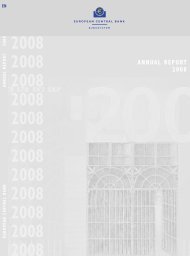Reserve Bank of Australia Annual Report 2011
Reserve Bank of Australia Annual Report 2011
Reserve Bank of Australia Annual Report 2011
You also want an ePaper? Increase the reach of your titles
YUMPU automatically turns print PDFs into web optimized ePapers that Google loves.
Foreign Exchange Operations<br />
The <strong>Reserve</strong> <strong>Bank</strong> is an active participant in the foreign exchange market. Most <strong>of</strong> its transactions are<br />
undertaken on behalf <strong>of</strong> the <strong>Reserve</strong> <strong>Bank</strong>’s clients, mainly the <strong>Australia</strong>n Government. The Government<br />
purchases foreign currency from the <strong>Bank</strong> to meet foreign currency obligations arising from certain defence<br />
expenditures, foreign aid commitments and the cost <strong>of</strong> maintaining its diplomatic missions around the world.<br />
In 2010/11, the <strong>Reserve</strong> <strong>Bank</strong> sold $7.4 billion <strong>of</strong> foreign currency to the <strong>Australia</strong>n Government. In the normal<br />
course <strong>of</strong> events, the <strong>Bank</strong> <strong>of</strong>fsets the sale <strong>of</strong> foreign currency to the Government in the market within a short<br />
time frame.<br />
The <strong>Reserve</strong> <strong>Bank</strong> also operates in the foreign<br />
exchange market to manage its international reserves.<br />
The currency exposure <strong>of</strong> international reserves<br />
is managed to a benchmark that has fixed target<br />
shares for each foreign currency (see below). Daily<br />
fluctuations in the relative values <strong>of</strong> these currencies<br />
shift the actual exposures to these currencies away<br />
from the targets. The <strong>Bank</strong> undertakes transactions<br />
each day to rebalance the currency exposures to<br />
the benchmark targets. These transactions are<br />
conducted in both the spot and forward markets and<br />
do not involve the <strong>Australia</strong>n dollar.<br />
In addition, the <strong>Reserve</strong> <strong>Bank</strong> undertakes transactions<br />
from time to time for a range <strong>of</strong> policy reasons:<br />
••<br />
Foreign exchange swaps are used periodically<br />
to smooth large domestic liquidity flows. These<br />
transactions work in the same way as repurchase<br />
agreements using domestic securities. The swaps<br />
can be for large amounts but are usually very<br />
short term. While turnover in these transactions<br />
totalled $50 billion for the year, the <strong>Bank</strong> had a<br />
negligible outstanding swap position at the end<br />
<strong>of</strong> June.<br />
Yen,<br />
Index<br />
100<br />
80<br />
60<br />
%<br />
3<br />
2<br />
1<br />
Yen per A$<br />
(LHS)<br />
TWI<br />
(LHS)<br />
<strong>Australia</strong>n Dollar<br />
US$ per A$<br />
(RHS)<br />
Euro per A$<br />
(RHS)<br />
AUD/USD volatility*<br />
l l l l<br />
0<br />
2007 2008 2009 2010 <strong>2011</strong><br />
* Daily absolute percentage change, 22-day rolling average<br />
Sources: RBA; Thomson Reuters; WM/Reuters<br />
••<br />
On occasion, the <strong>Bank</strong> operates in the foreign exchange market with the objective <strong>of</strong> influencing the level<br />
<strong>of</strong> the exchange rate or market conditions. The factors behind the decision to conduct these operations,<br />
which are commonly known as foreign exchange intervention, tend to be specific to the particular episode.<br />
The most recent round <strong>of</strong> intervention took place in late 2008, when liquidity in the local foreign exchange<br />
market was compromised following the collapse <strong>of</strong> Lehman Brothers.<br />
••<br />
From time to time, the <strong>Bank</strong> also undertakes transactions to adjust the level <strong>of</strong> its foreign currency holdings.<br />
These transactions might be undertaken to unwind the impact <strong>of</strong> intervention on the level <strong>of</strong> reserves<br />
or to move to a new target level. The transactions are conducted with the aim <strong>of</strong> having the minimum<br />
possible impact on the exchange rate and market conditions.<br />
The <strong>Australia</strong>n dollar appreciated against most currencies over the year but particularly against the US dollar.<br />
The local currency was underpinned by further increases in commodity prices, the relatively strong domestic<br />
economy and expectations <strong>of</strong> tighter monetary policy. In July, the <strong>Australia</strong>n dollar reached a post-float<br />
high against the US dollar and on a trade-weighted basis. Despite bouts <strong>of</strong> risk aversion associated with the<br />
US$,<br />
Euro<br />
1.0<br />
0.8<br />
0.6<br />
%<br />
3<br />
2<br />
1<br />
0<br />
ANNUAL REPORT <strong>2011</strong> | Operations in Financial Markets<br />
19





![KNOW YOUR NEW GIBRALTAR BANKNOTES - [Home] bThe/b](https://img.yumpu.com/50890985/1/184x260/know-your-new-gibraltar-banknotes-home-bthe-b.jpg?quality=85)
![PAPUA NEW GUINEA - [Home] - Polymer Bank Notes of the World](https://img.yumpu.com/49758743/1/190x143/papua-new-guinea-home-polymer-bank-notes-of-the-world.jpg?quality=85)










